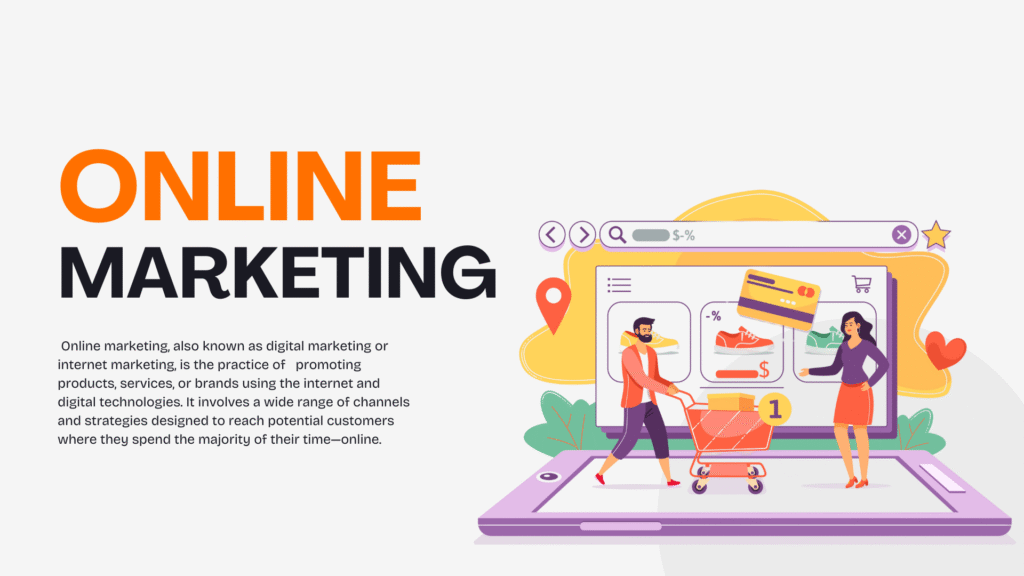In today’s digital world, online marketing is no longer optional—it’s essential. With billions of people accessing the internet daily, businesses that want to thrive must establish a solid online presence. Whether you’re a startup, a growing company, or a seasoned entrepreneur, understanding the fundamentals and latest trends of online marketing can dramatically boost your brand’s visibility, engagement, and sales.
This guide walks you through everything you need to know about online marketing in 2025—from strategies and channels to tools and best practices.
What is Online Marketing?
Online marketing, often known as digital marketing or internet marketing, is the practice of using the internet and digital technologies to advertise products, services, or brands. Using a range of channels and tactics, it engages with potential clients online, where they spend the majority of their time.
Unlike traditional marketing methods (such as print ads, billboards, or TV commercials), online marketing allows businesses to target specific audiences, track performance in real time, and adapt quickly to changes.
Key Elements of Online Marketing:
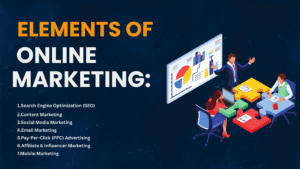
- Search Engine Optimization (SEO)
increasing visibility and organic traffic by optimising your content and website to rank better in search engine results. - Content Marketing
Creating and distributing valuable, relevant content (like blogs, videos, or infographics) to attract and engage your audience. - Social Media Marketing
Using platforms like Facebook, Instagram, LinkedIn, and TikTok to build brand awareness, interact with users, and run paid promotions. - Email Marketing
Sending targeted emails to subscribers to nurture leads, announce offers, and retain customers. - Pay-Per-Click (PPC) Advertising
Running paid ads on search engines or social platforms, where you only pay when someone clicks on your ad. - Affiliate & Influencer Marketing
Partnering with affiliates or influencers who promote your product in exchange for a commission or fee. - Mobile Marketing
Reaching users on mobile devices via SMS, in-app ads, push notifications, or mobile-optimized content.
Benefits of Online Marketing:
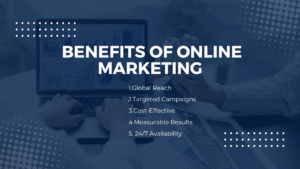
- Global Reach: Access audiences around the world.
- Targeted Campaigns: Reach people based on demographics, interests, and behavior.
- Cost-Effective: Many strategies (like SEO and content marketing) offer long-term ROI with lower costs.
- Measurable Outcomes: Monitor what is and is not functioning via analytics.
- 24/7 Availability: Your online presence never sleeps.
Why Online Marketing Matters
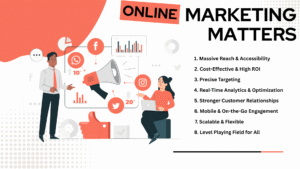
In today’s fast-paced digital world, online marketing is no longer optional—it’s essential. Whether you’re a small startup or a global enterprise, online marketing helps you reach your target audience, build meaningful relationships, and grow your business more effectively than traditional methods ever could.
1. Massive Reach & Accessibility
Over 5 billion people use the internet—meaning your audience is online right now.
- You can reach global customers from any location.
- Small businesses can compete with large corporations.
- Social media, SEO, and ads put your brand in front of the right eyes.
2. Cost-Effective & High ROI
Compared to traditional advertising, digital campaigns are far less expensive.
- SEO and content marketing can drive long-term traffic for free.
- PPC and social ads let you set your own budget and pay only when users engage.
- Email marketing has one of the highest ROIs, with a $36 return for every $1 spent (on average).
3. Precise Targeting
Online marketing tools let you define exactly who sees your message based on:
- Demographics (age, gender, income)
- Behavior (web activity, past purchases)
- Interests (pages liked, searches made)
4. Real-Time Analytics & Optimization
Track everything: clicks, opens, bounce rates, conversions—in real time.
- Adjust campaigns instantly for better performance.
- Use A/B testing to refine headlines, images, CTAs, and more.
- Make data-driven decisions instead of guessing.
5. Stronger Customer Relationships
Engage directly with your audience through:
- Social media interactions
- Email newsletters
- Personalized content and recommendations
6. Mobile & On-the-Go Engagement
With the majority of users browsing on smartphones, online marketing allows you to:
- Reach people wherever they are
- Use mobile ads, SMS, and responsive websites
- Provide seamless experiences across devices
7. Scalable & Flexible
Whether you’re launching a campaign for 10 people or 10 million, online marketing scales easily.
- Test small before scaling up
- Tailor campaigns for local, regional, or global audiences
- Pivot quickly based on performance
8. Level Playing Field for All
Even small businesses or solo entrepreneurs can compete with big players.
- A viral video or smart campaign can outperform a million-dollar ad.
- Authentic storytelling and niche targeting matter more than massive budgets.
Core Components of Online Marketing
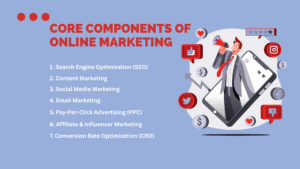
Let’s break down the key elements of a strong online marketing strategy:
1. Search Engine Optimization (SEO)
Optimising your content and website to rank better in search engine results pages (SERPs) is known as SEO. The higher you rank, the more organic (unpaid) traffic you receive.
Key SEO strategies include:
- Keyword research
- On-page optimization (meta tags, headings, internal linking)
- Mobile-friendly and fast-loading design
- Quality backlinks
- Content creation
Try these tools: Yoast SEO, Ahrefs, SEMrush, and Google Search Console.
2. Content Marketing
The core objective of content marketing is to produce valuable, relevant information that will interest and hold your audience’s attention. It’s about educating and inspiring rather than just selling.
Examples of content:
- Blog posts
- Ebooks
- Infographics
- Videos
- Podcasts
Tips for success:
- Know your audience
- Use storytelling
- Repurpose content across platforms
- Optimize for SEO
Tools to try: Grammarly, Canva, HubSpot, BuzzSumo.
3. Social Media Marketing
Audiences congregate, converse, and interact with brands on social media. It’s an essential channel for visibility, community building, and conversions.
Popular platforms:
- Twitter/X
- TikTok
Social strategies:
- Post consistently
- Use visuals and video
- Engage with followers
- Run paid campaigns
- Use hashtags and trends
Tools to try: Hootsuite, Buffer, Later, Sprout Social.
4. Email Marketing
Despite the rise of new platforms, email remains one of the highest-converting marketing channels. It’s direct, personal, and measurable.
Best practices:
- Segment your audience
- Personalize messages
- Use strong subject lines
- Automate with workflows
- Include clear CTAs (calls-to-action)
Popular email platforms: Mailchimp, ActiveCampaign, ConvertKit, Klaviyo.
5. Pay-Per-Click Advertising (PPC)
PPC allows you to display ads on platforms like Google, Facebook, and Instagram and pay only when someone clicks.
Types of PPC ads:
- Google Search Ads
- Display Ads (banners)
- Social media ads (Facebook, LinkedIn, etc.)
- Shopping Ads
Tips for effective PPC:
- Research keywords
- Test ad copy
- Use retargeting
- Optimize landing pages
Try Google Ads, Facebook Ads Manager, and AdEspresso.
6. Affiliate & Influencer Marketing
In affiliate marketing, other people promote your products for a commission. Influencer marketing involves paying or collaborating with influencers to reach their followers.
Why it works:
- Builds trust
- Taps into new audiences
- Often more affordable than traditional ads
Tips:
- Choose affiliates/influencers who align with your brand
- Set clear terms and tracking
- Monitor performance
7. Conversion Rate Optimization (CRO)
CRO focuses on turning visitors into customers. It’s not just about driving traffic—it’s about getting results.
Tactics include:
- A/B testing
- Improving UX (user experience)
- Clear CTAs
- Streamlining checkout
- Reducing bounce rates
Tools to try: Hotjar, Optimizely, Unbounce.
Online Marketing Trends in 2025
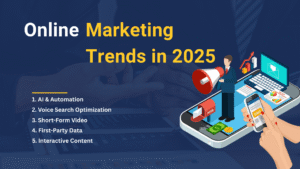
To stay competitive, businesses must adapt to changing trends. Here’s what’s hot in 2025:
1. AI & Automation
AI is powering personalized experiences, chatbots, and smarter ad targeting.
2. Voice Search Optimization
Content optimisation for voice questions is essential as smart speakers become more popular.
3. Short-Form Video
TikTok, Instagram Reels, and YouTube Shorts are driving engagement with fast, creative content.
4. First-Party Data
As cookies phase out, brands are focusing on collecting and using their own data ethically.
5. Interactive Content
Polls, quizzes, and 360° videos increase engagement and time on site.
How to Build Your Online Marketing Strategy

- Clearly define your objectives. What do you hope to accomplish? More leads? More traffic?
- Know your audience – Define buyer personas to tailor your messaging.
- Choose the relevant channels: Observe which websites have the highest levels of audience engagement.
- Create a content calendar to plan and create content ahead of time.
- Measure and refine – Use analytics to track performance and adjust strategy.
Measuring Success
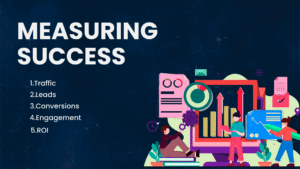
Track your efforts with these metrics:
- Traffic: How many people visit your site or pages?
- Leads: How many potential customers are you capturing?
- Conversions: How many visitors take the desired action?
- Engagement: Are people interacting with your content?
- ROI Are your expenses more than the value you produce?
Advanced Online Marketing Techniques
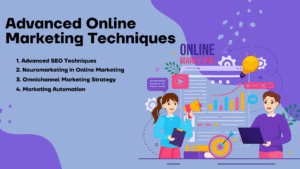
1. Advanced SEO Techniques
If you’re past the basics of SEO, it’s time to level up.
➤ Topic Clusters & Pillar Pages
Organize your content around central themes (pillar pages) with supporting blog posts (clusters). This structure boosts SEO and keeps users engaged.
Example: A fitness site can have a pillar page on “Weight Loss” linking to clusters like “Low-Carb Diets,” “Cardio Workouts,” and “Supplements.”
➤ Schema Markup
Use structured data (Schema.org) to help search engines understand your content and display rich results (like reviews, FAQs, etc.).
➤ Voice Search Optimization
Optimize for long-tail, conversational queries. Think: “What’s the best skincare routine for oily skin?”
2. Neuromarketing in Online Marketing
Neuromarketing uses psychological triggers to influence consumer behavior.
- FOMO (Fear of Missing Out): Add countdown timers or “only 3 left” messages.
- Social Proof: Show testimonials, reviews, or user numbers.
- Color Psychology: Red triggers urgency, blue builds trust.
3. Omnichannel Marketing Strategy
Being on multiple platforms isn’t enough—they need to work together.
Example:
- A user sees your Facebook ad
- Visits your website and joins the email list
- Gets a retargeted offer on Instagram
- Makes a purchase via email reminder
Use tools like Klaviyo, HubSpot, or ActiveCampaign to sync messaging across channels.
4. Marketing Automation
Businesses can save time and achieve better results by using marketing automation software to automate and streamline marketing operations like lead nurturing, email campaigns, and customer segmentation.
Automation ideas:
- Welcome email sequences
- Abandoned cart emails
- Lead scoring
- Drip campaigns based on behavior
Top tools: Zapier, Mailchimp, Active Campaign, Salesforce Marketing Cloud.
Common Mistakes in Online Marketing (And How to Fix Them)
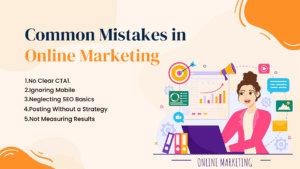
- No Clear CTA: Every page should guide users to act—subscribe, buy, share, etc.
- Ignoring Mobile: Over 60% of traffic is mobile. Your site must be responsive and fast.
- Neglecting SEO Basics: Broken links, missing alt tags, and slow load times kill rankings.
- Posting Without a Strategy: Every piece of content should serve a purpose.
- Not Measuring Results: If you don’t track it, you can’t improve it.
Must-Have Tools for Every Marketer
| Category | Tool | Description |
| SEO | Ahrefs / SEMrush | Keyword tracking, backlinks, audits |
| Content | Grammarly / Surfer SEO | Writing & optimization |
| ConvertKit / Mailchimp | Email automation | |
| Analytics | Google Analytics / Hotjar | Track and visualize user behavior |
| Social Media | Hootsuite / Buffer | Scheduling and monitoring |
| Ads | Facebook Ads Manager / Google Ads | Campaign creation & performance |
Use tools like Google Analytics, HubSpot, or social insights dashboards to monitor your results.
Final Thoughts
Online marketing is a dynamic, ever-evolving field. What works today might change tomorrow, but the core principle remains: provide value, build relationships, and meet your audience where they are.
You can construct a strong marketing ecosystem that promotes growth and fosters brand loyalty by integrating SEO, content, social media, email, paid advertisements, and data analytics.
Stay curious, test often, and never stop learning—because in the world of online marketing, change is the only constant.

